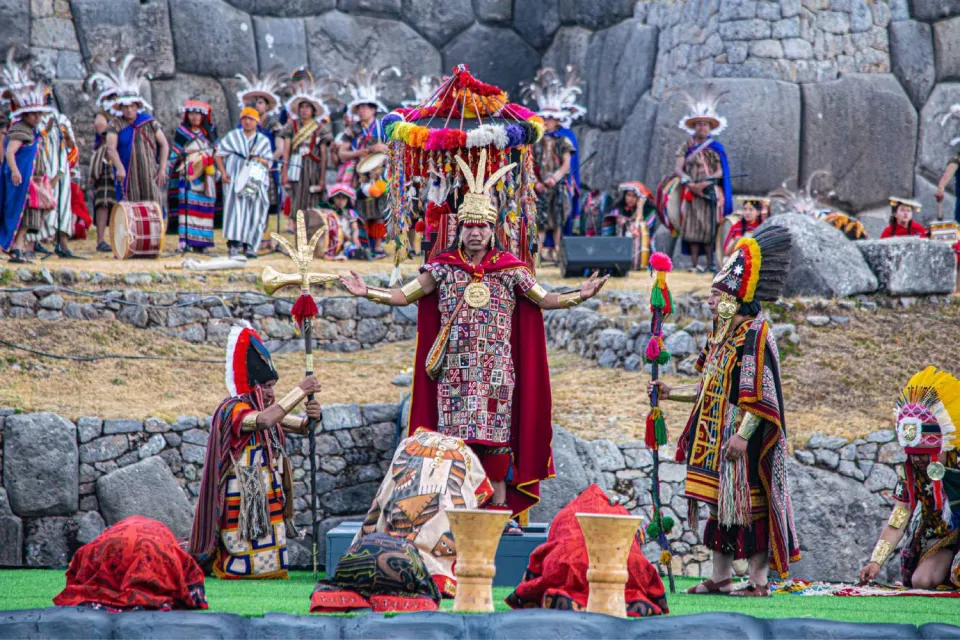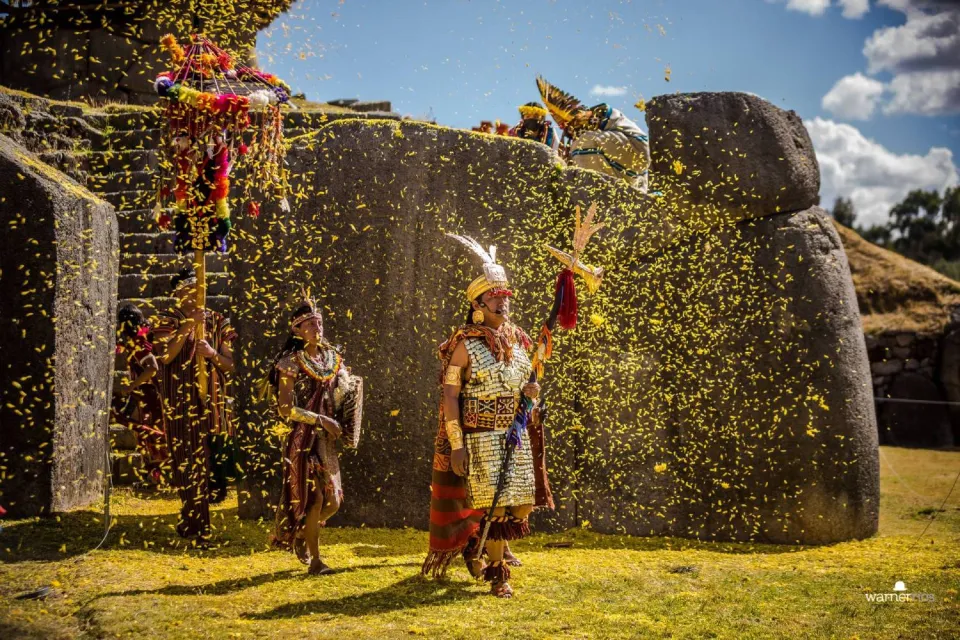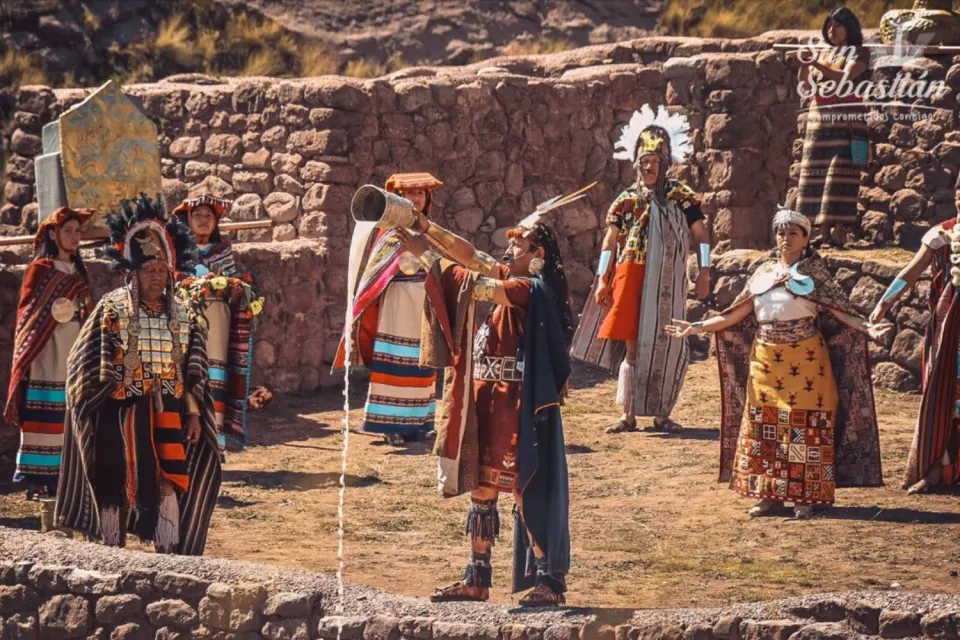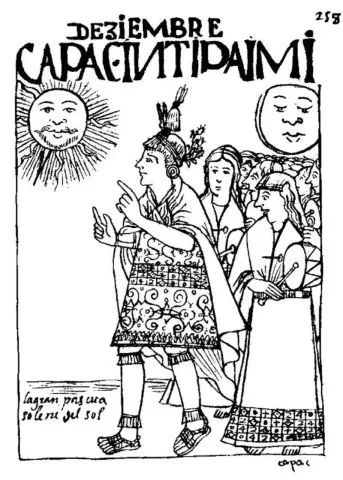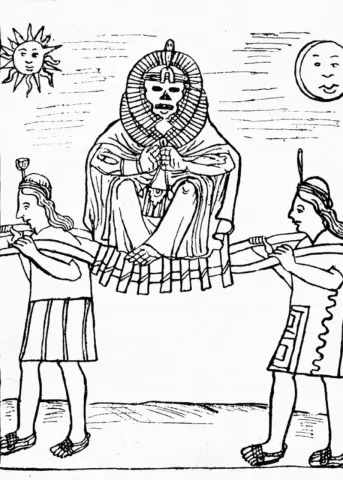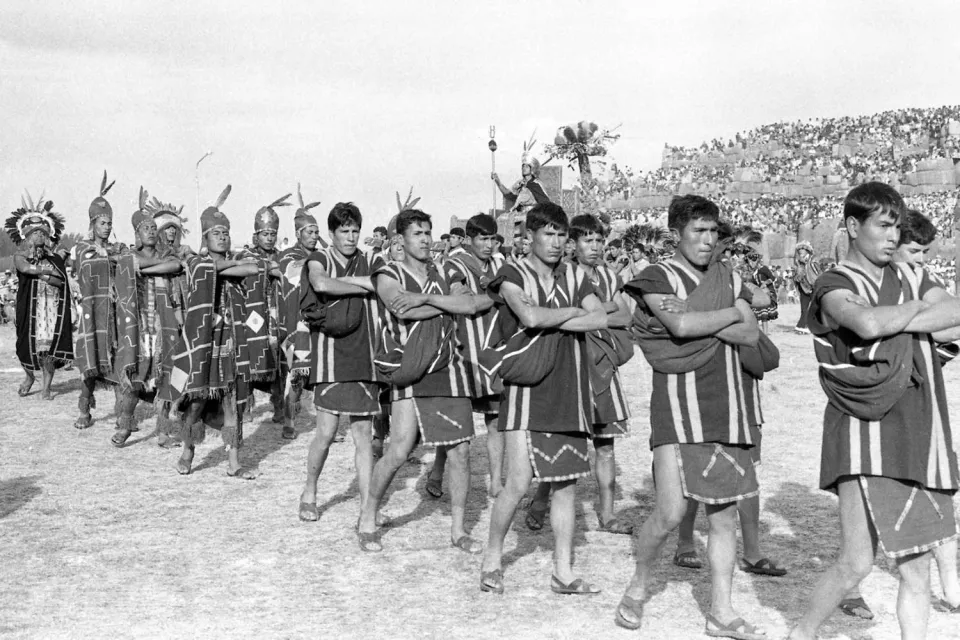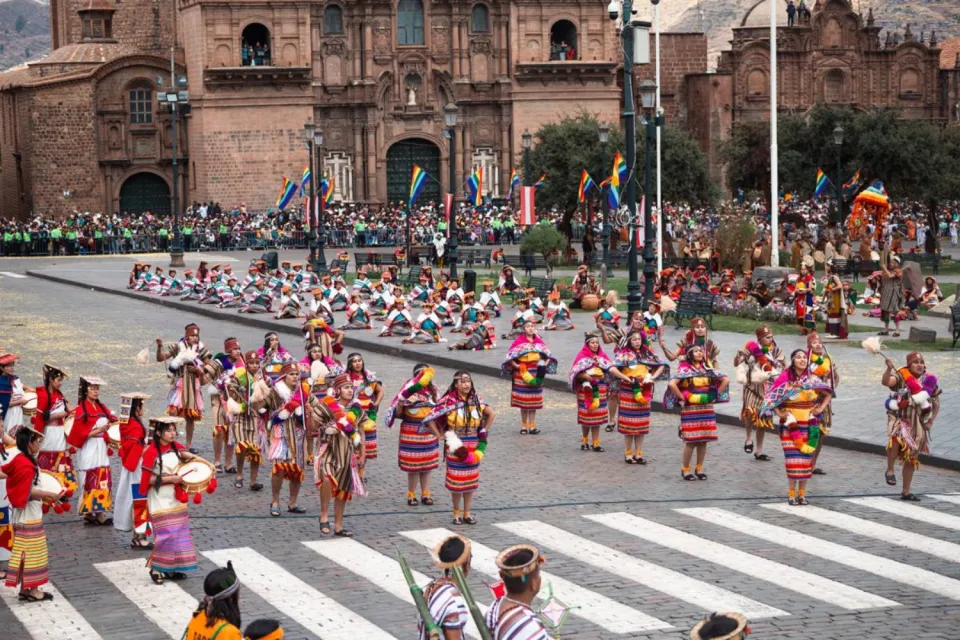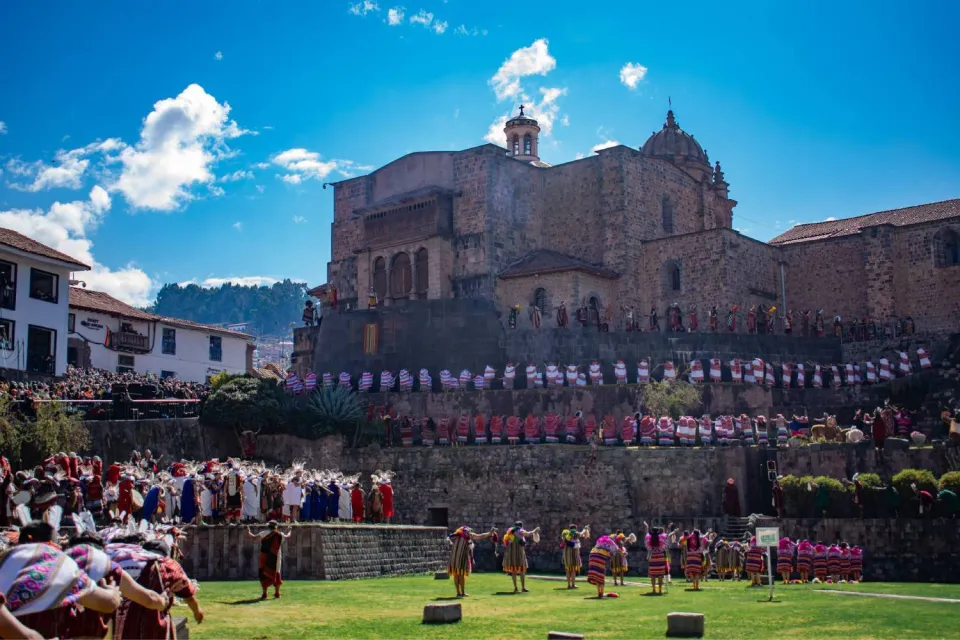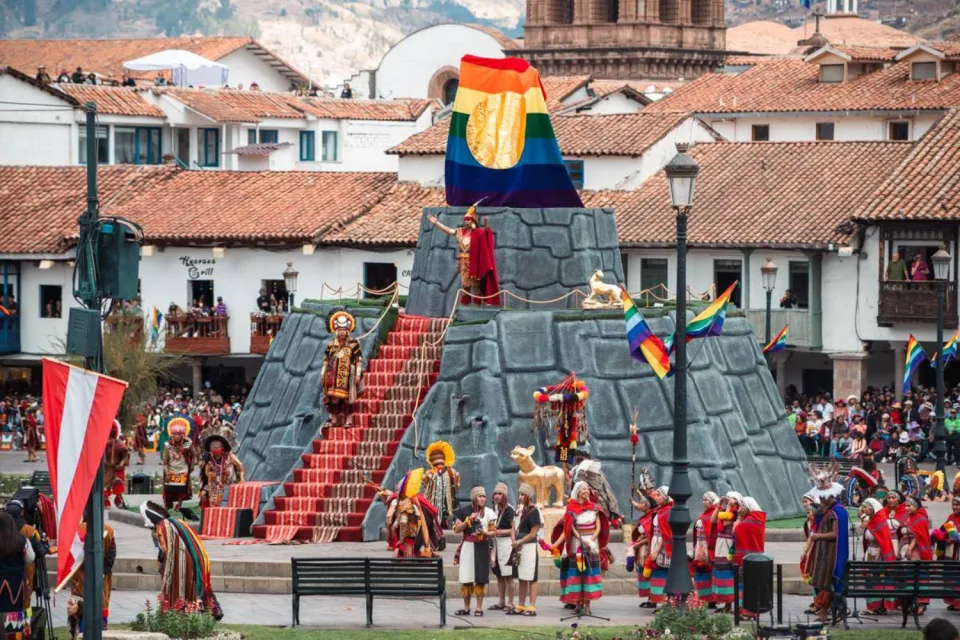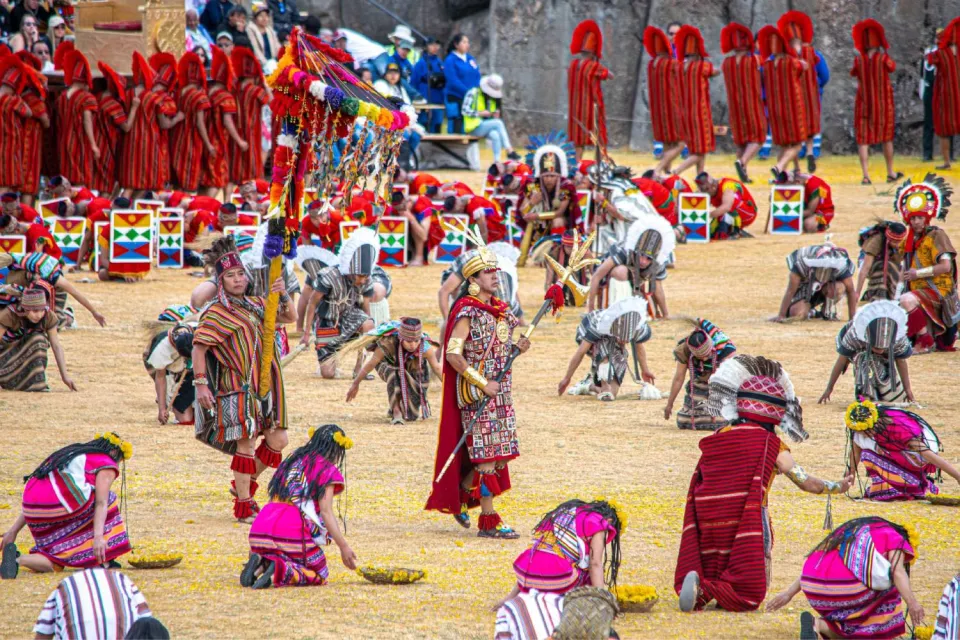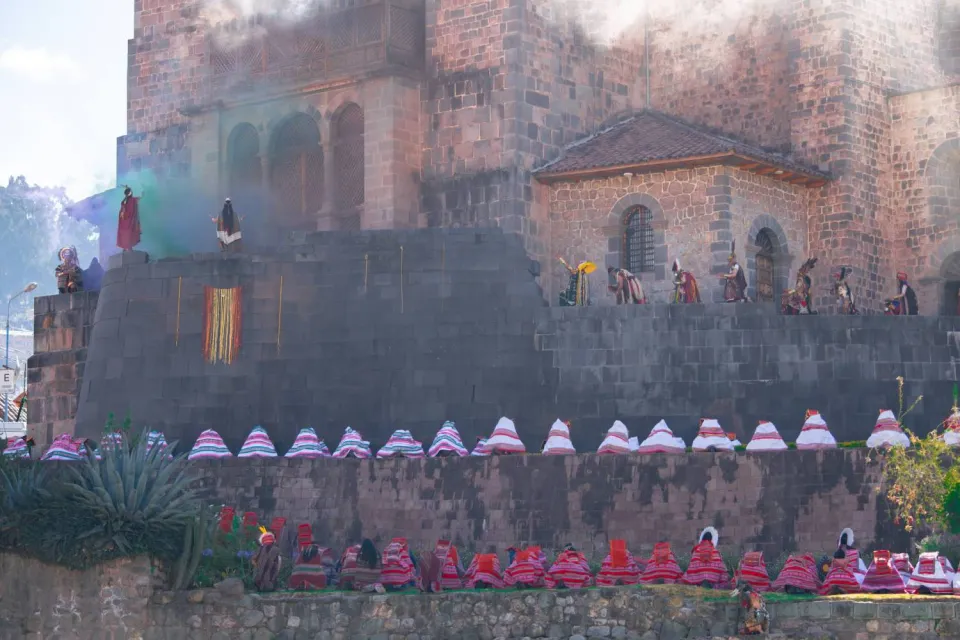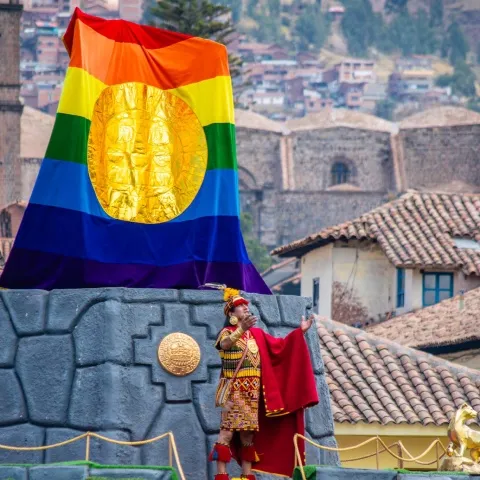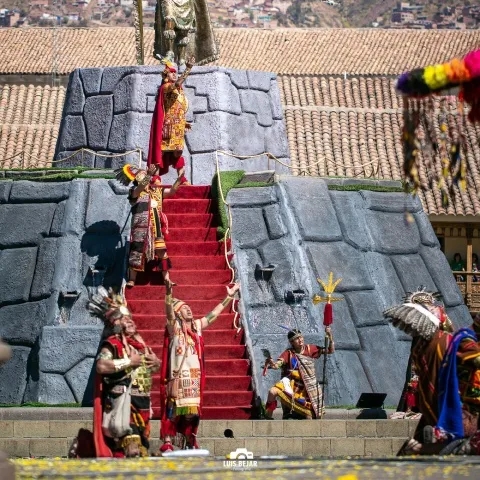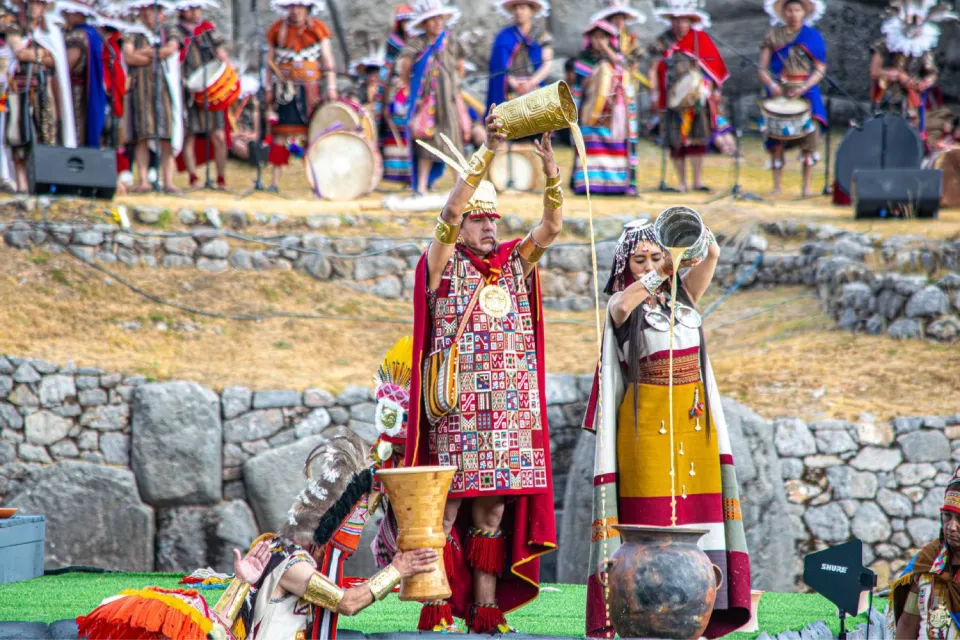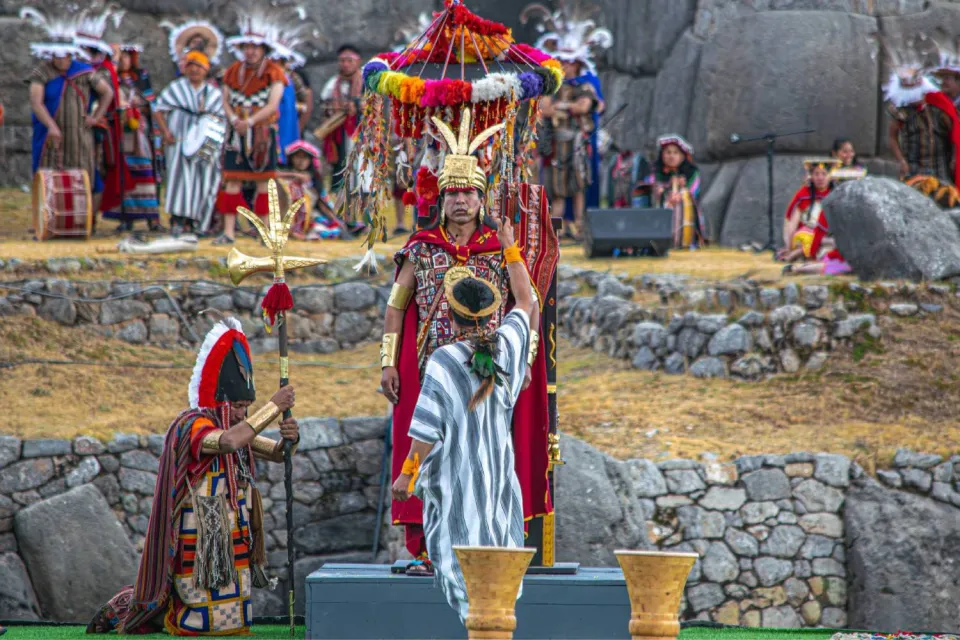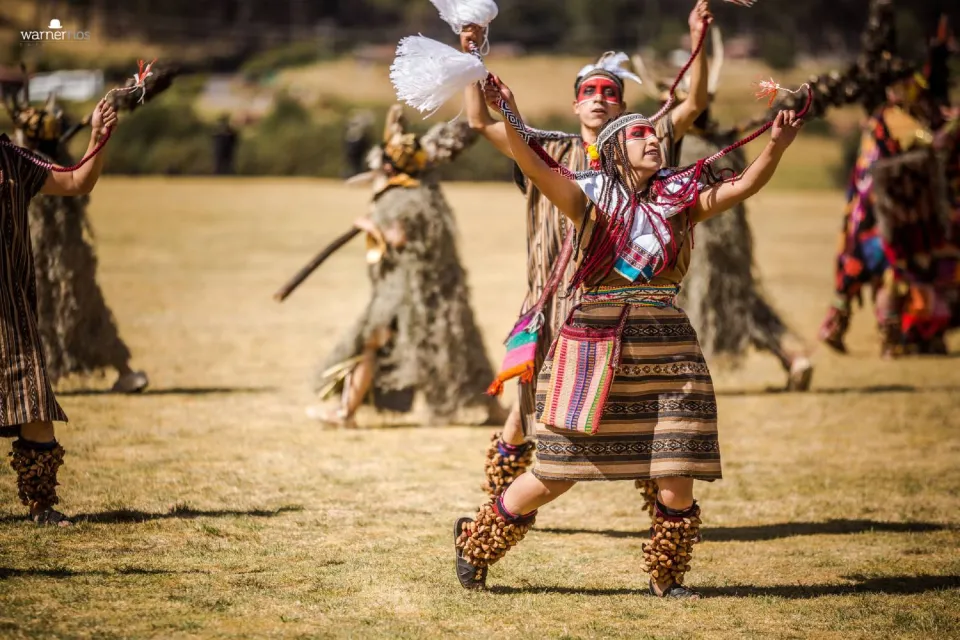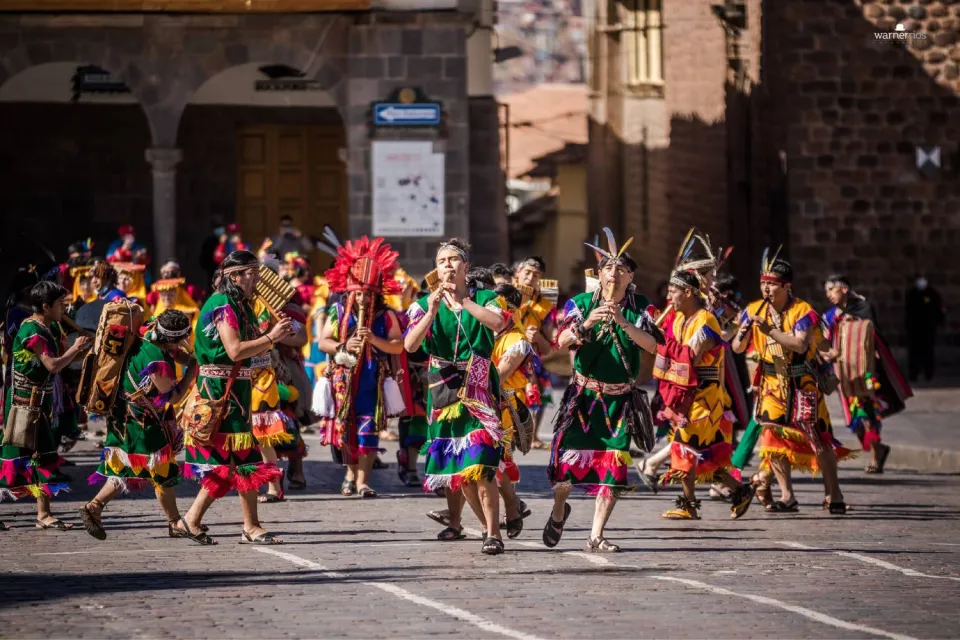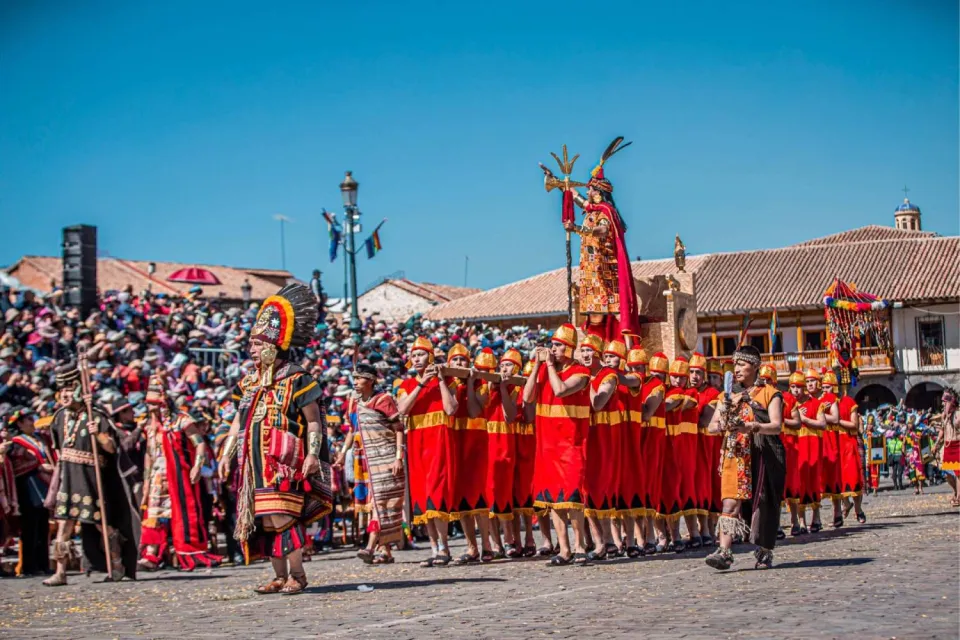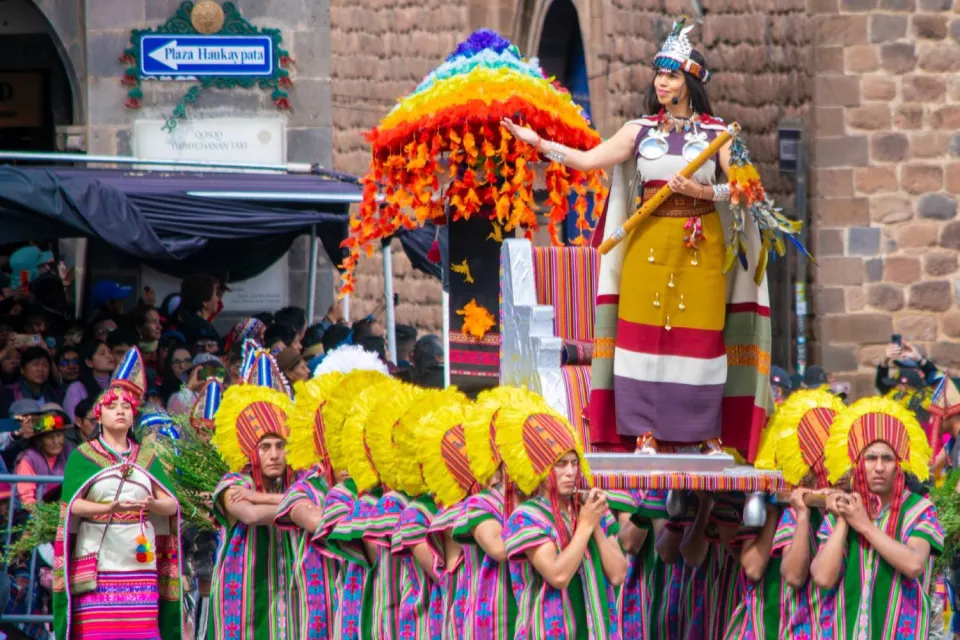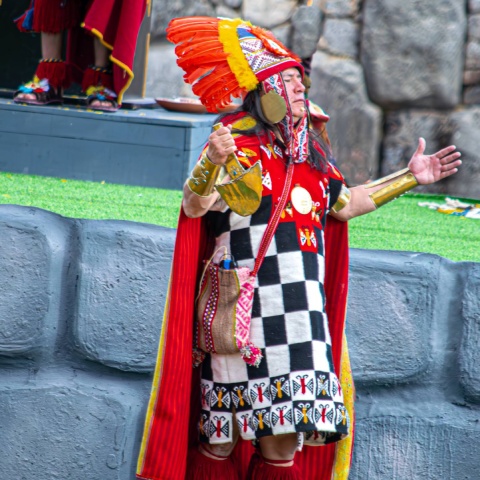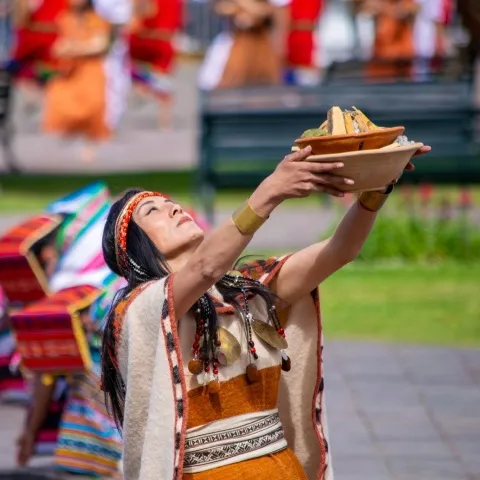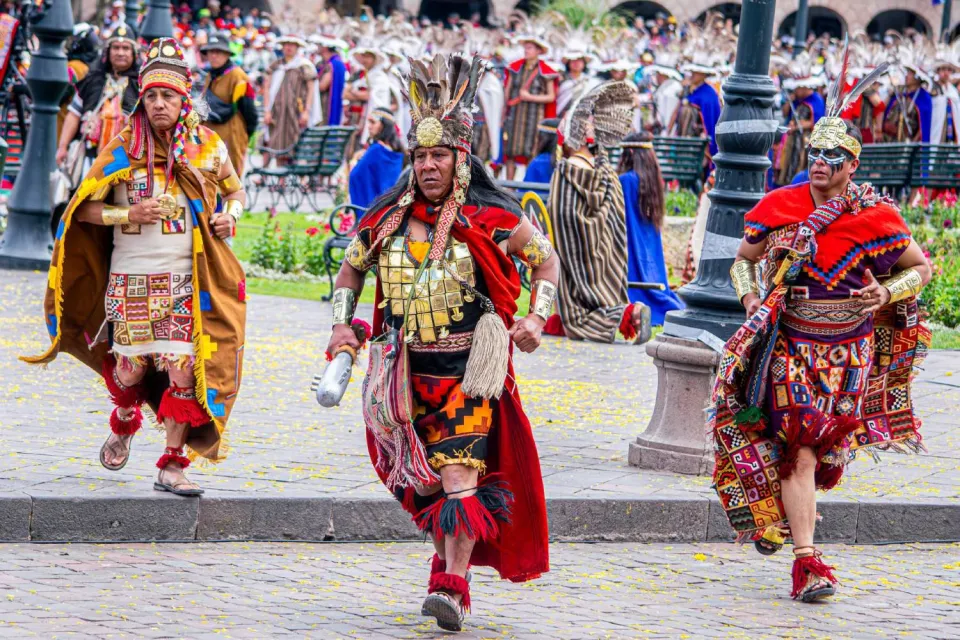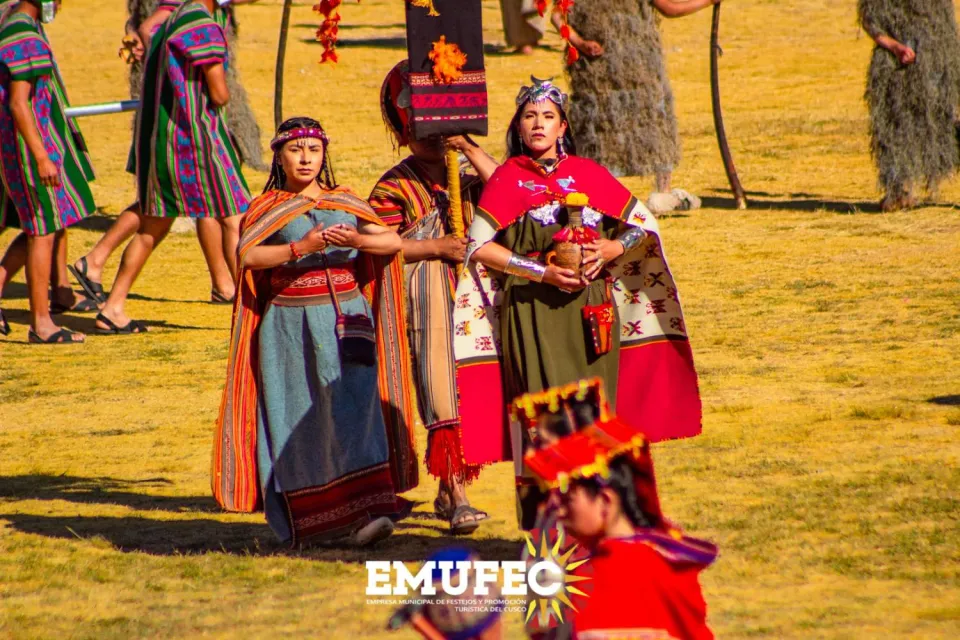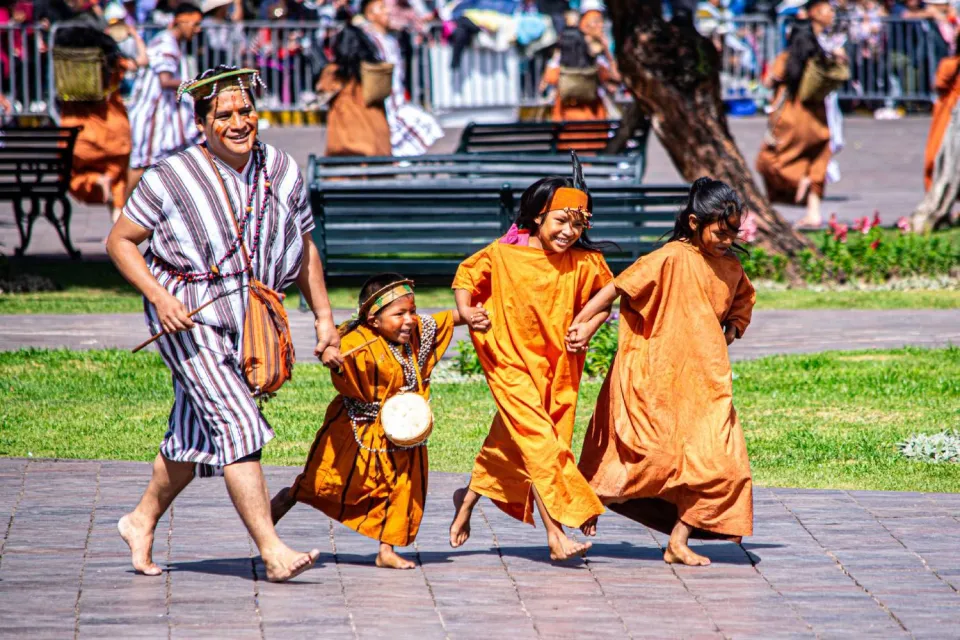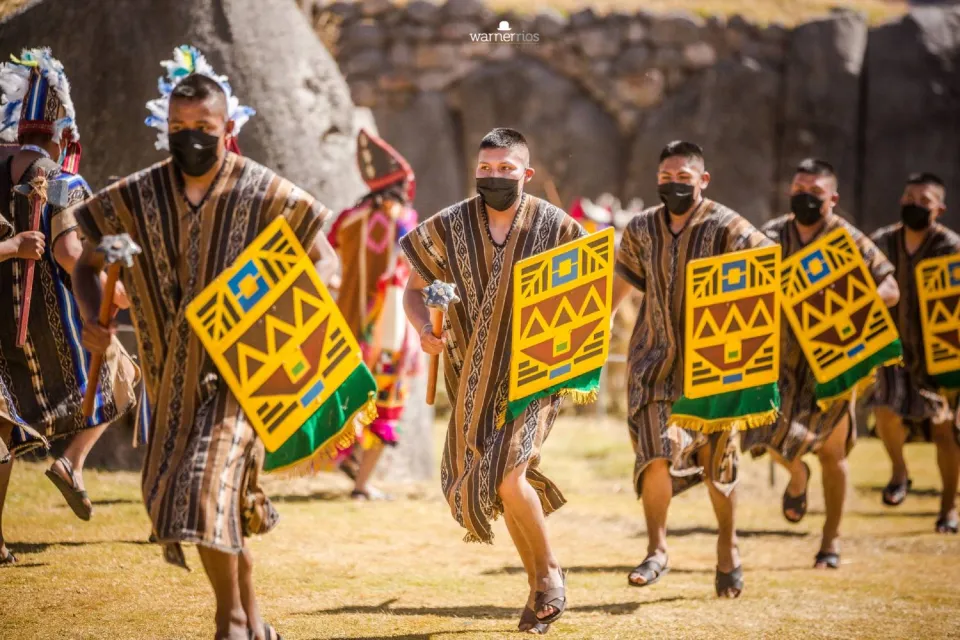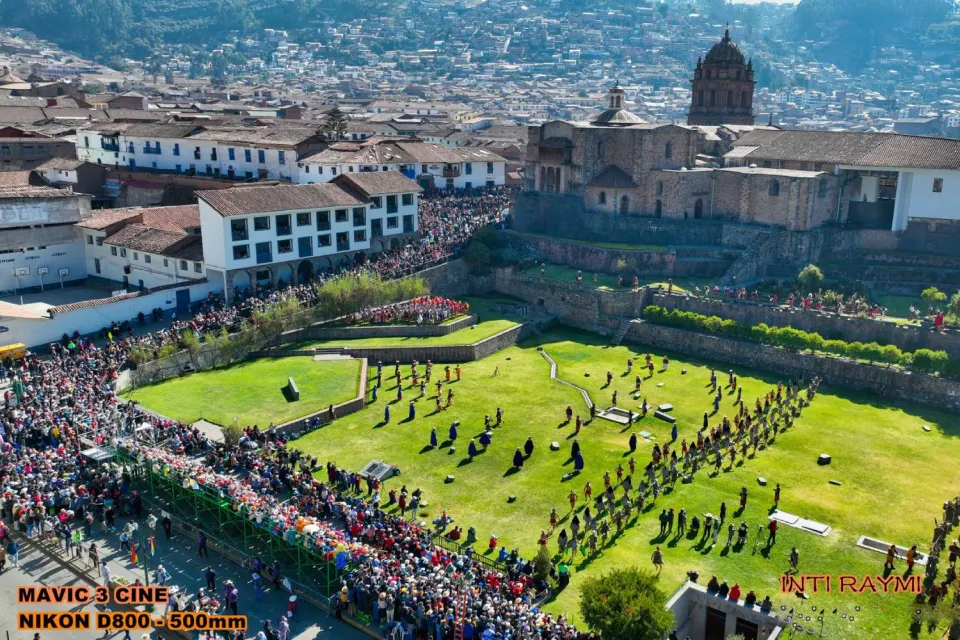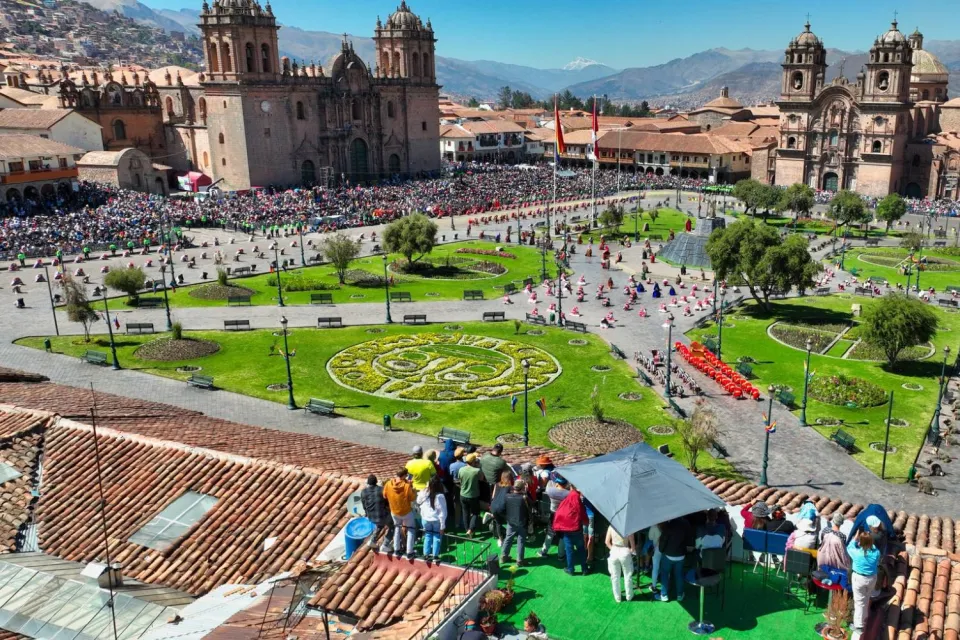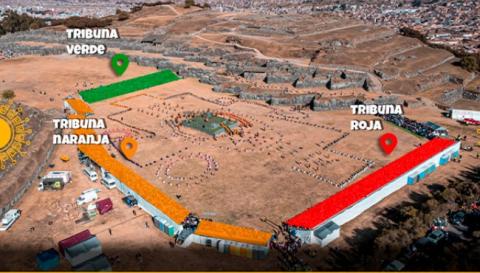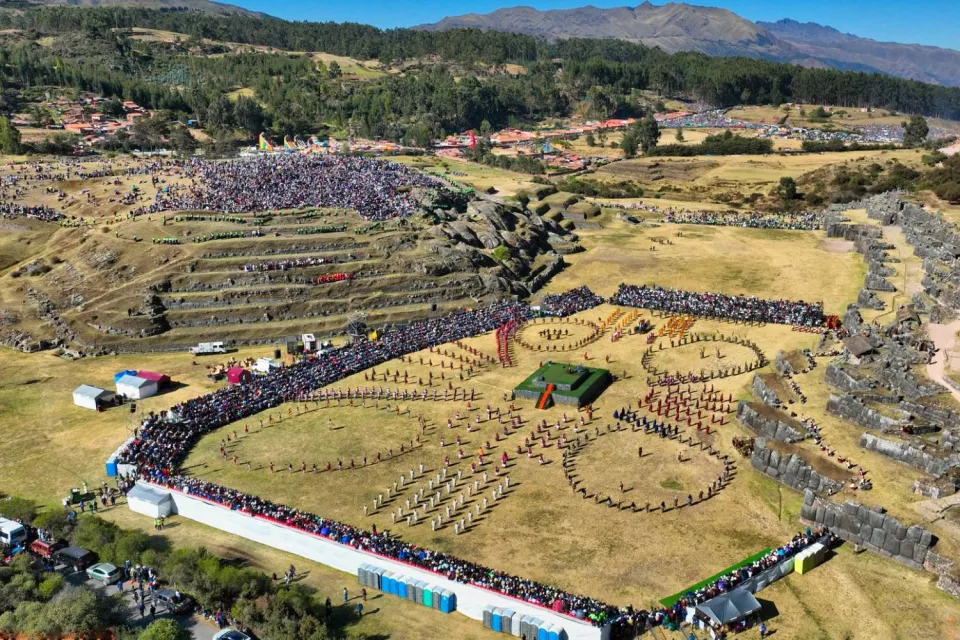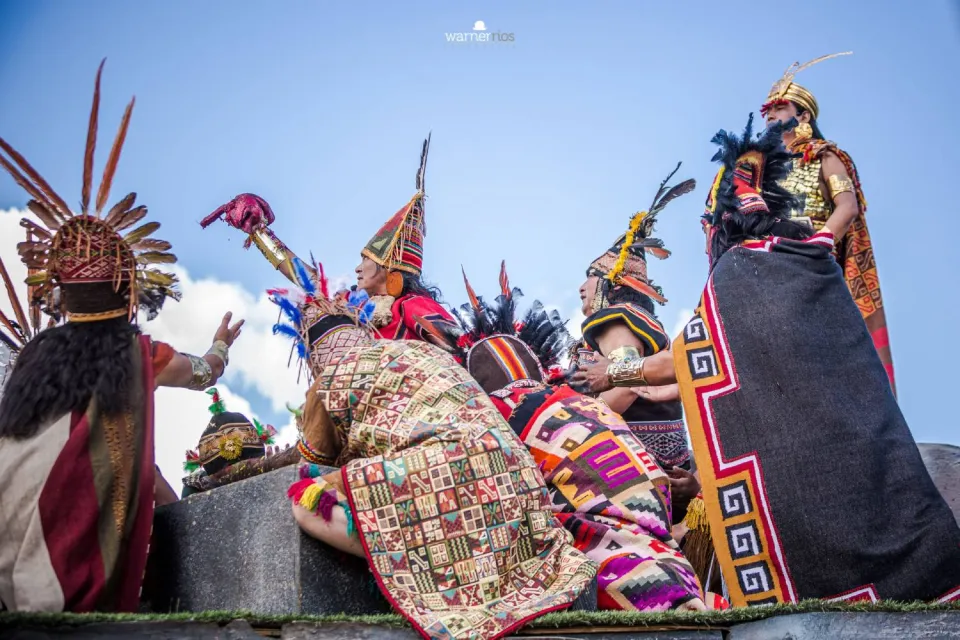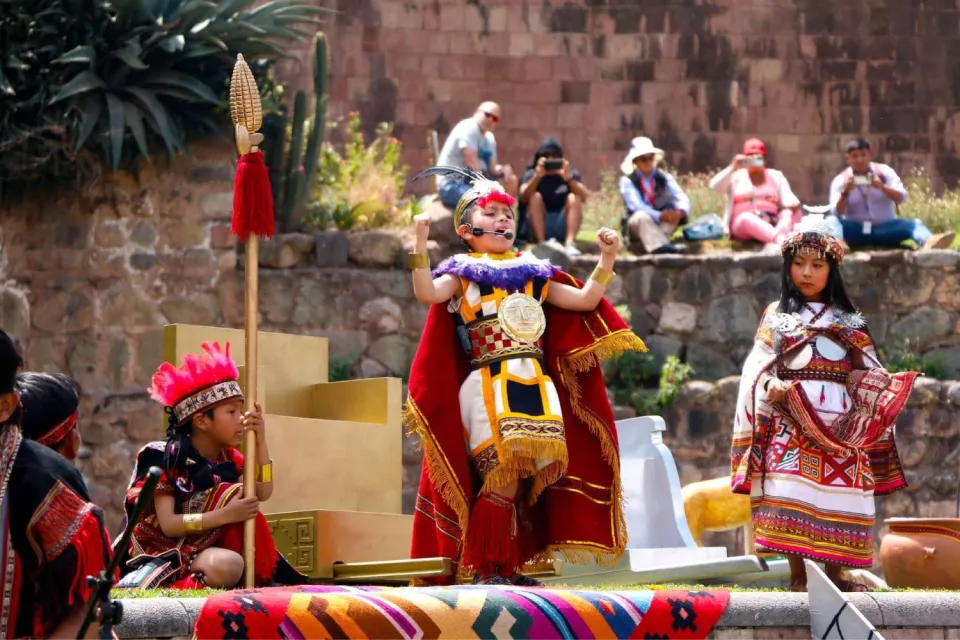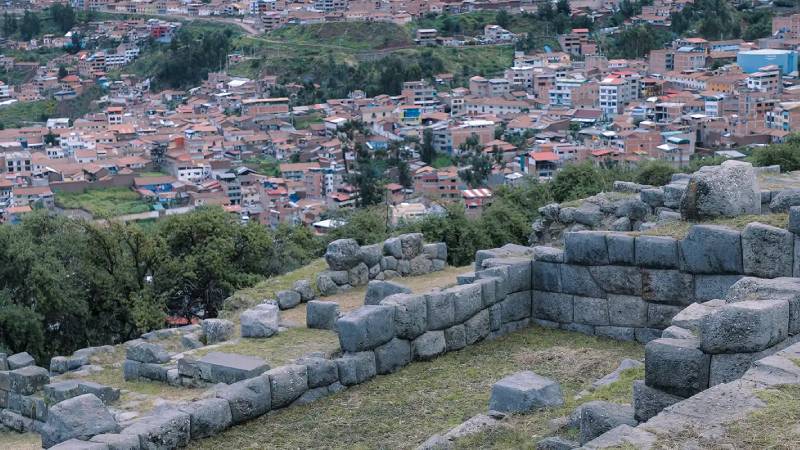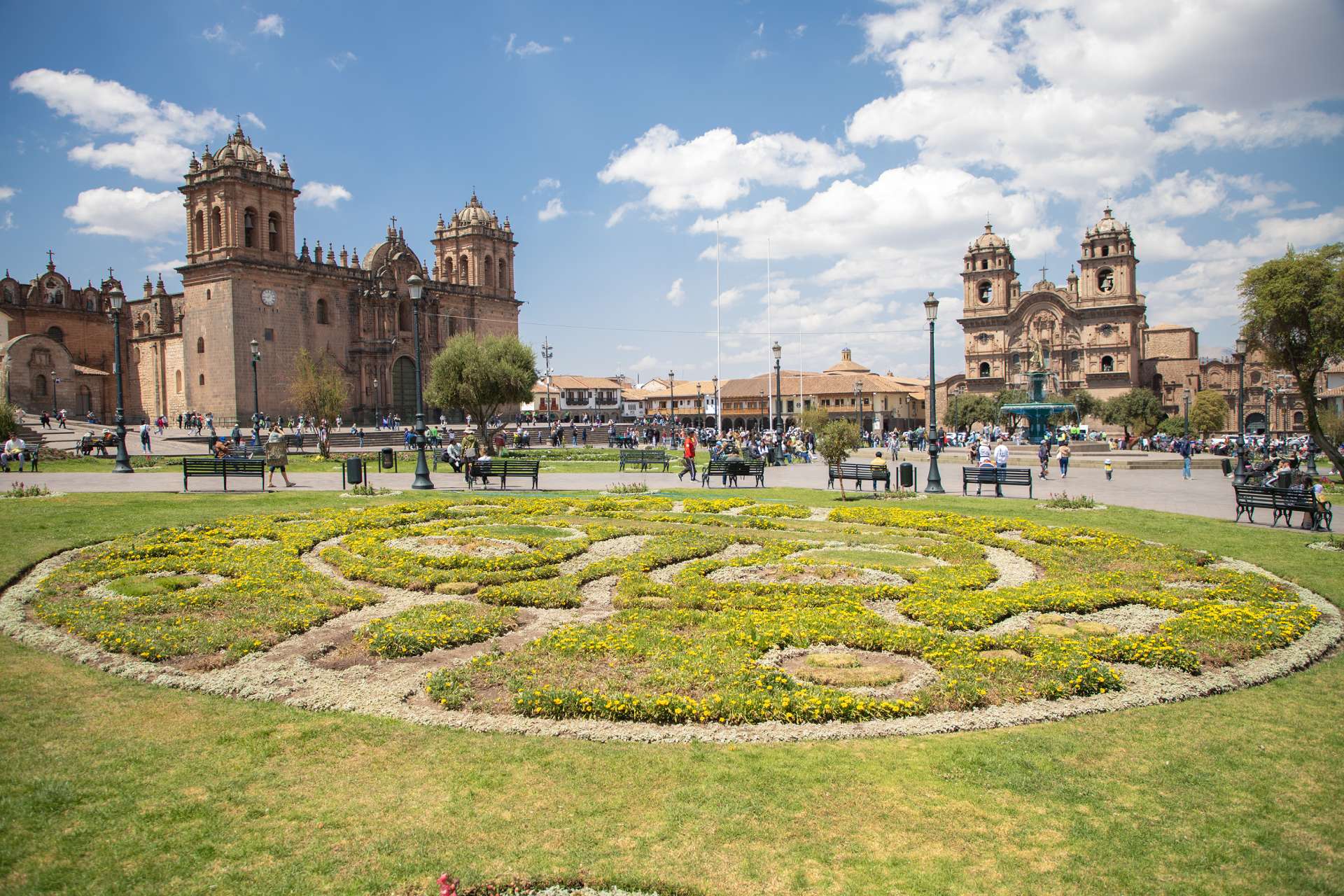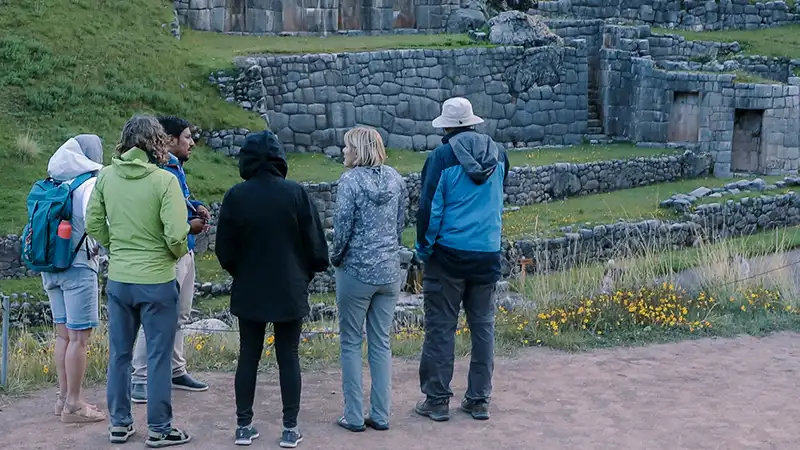Forbidden by the conquistadors and revived centuries later, this Inca festival rises every June 24 to remind us that the Sun still shines over the lands of Tahuantinsuyo.
If you want to discover why Inti Raymi is more than a festival-it is a symbol of identity and cultural pride-this article is for you.
What is the Inti Raymi in Cusco?
The Inti Raymi is the staging of the Wawa Inti Raymi, the greatest religious festival of the Tahuantinsuyo Empire. The Inca Pachacutec established it in 1430 A.D. in the heart of the empire, the city of Cusco, to celebrate the first day of the Andean New Year.
Not only did the Incas consider it their most important celebration, but historians also believe that it was the most grandiose festivity in all of South America. During this ancient festival, the Incas worshipped the Sun God (Inti), one of the most important deities of their culture. The celebration lasted 15 days, during which the Incas performed sacrifices, dances, music, and processions.
The Inti Raymi honors the Sun to ask for good harvests and protection for the Andean communities. This tradition has endured over the centuries and, today, continues to fill the streets of Cusco with magic and color.
Every June 24, in Cusco, this staging takes place. Local actors prepare for months to recreate every detail of the characters, avoiding the loss of any aspect of this ancient festivity. With the passage of time, Inti Raymi has become one of the largest cultural and traditional manifestations in the world, attracting both national and foreign tourists.
What does inti raymi mean?
The name Inti Raymi literally means “Festival of the Sun” or “Festivity in honor of the sun” in Quechua, the indigenous language of the Incas.
Where:
- Inti, which means sun
- Raymi, which means festivity, feast or celebration
Why is inti raymi celebrated on june 24?
People celebrate Inti Raymi on June 24 because it coincides with the winter solstice in the southern hemisphere, the shortest day of the year. For the Incas, this day marked the rebirth of the Sun, which returned after having moved away, bringing with it longer days and the beginning of the Andean New Year.
What does the sun symbolize within the festivity?
In Inti Raymi, the Sun symbolizes life, power and divinity. For the ancient Incas, Inti was the supreme god and the creator of all that existed. He represented the source of life and the abundance of harvests, besides being the protector of the Empire.
Why is inti raymi so special?
Inti Raymi symbolizes the deep connection between human beings and nature, especially with the Sun, source of life and energy. It is a way of giving thanks for the light that allows us to cultivate the land and survive in the heights of the Andes.
In addition, it represents:
- Renewal: The solstice marks the beginning of a new stage of light and warmth.
- Unity: It brings together communities and visitors to celebrate a shared cultural identity.
- Respect for the ancestors: It keeps alive the history and teachings of the Incas.
History of Inti Raymi
Worship before the Incas
Before the formation of the Tahuantinsuyo empire, the worship of the Sun God already existed among cultures such as the Pukara, Tiahuanaco, Supe, Moche, Recuay, Paracas, Pajaten and Wari.
When the Incas began their territorial expansion, they did not face major religious conflicts, since the conquered cultures could continue to worship their Sun God.
Origins of the Inti Raymi
With the arrival of Manco Capac to the valley of Cusco, the era of the Tahuantinsuyo began. He promoted the cult of the god Inti and organized a special ceremony in the sacred hill of Huanacauri, where the golden rod of Manco Capac sank as a divine sign to found the Inca Empire.
It is considered that this ceremony, similar to the Inti Raymi, was its origin. This festivity continued under the government of Yahuar Huácac and, finally, the Inca Pachacútec consolidated it in the 15th century (1430 A.D.) as the most important official festivity for the Incas. He designated new scenarios for its celebration, giving shape to the ceremony as we know it today in the stagings of Cusco.
The Inca Pachacutec intended with the Inti Raymi to express devotion and gratitude to the Sun, reinforce founding myths, honor the first rulers and offer the people a reason to rejoice and unite.
The Ceremony in the time of the Inca Empire
People celebrated the Inti Raymi in the Temple of the Sun (Qorikancha) and in the Haucaypata (the current Plaza de Armas of Cusco), making it last between 15 and 30 days. The Inca himself conducted the ceremony, as he was considered the son of the Sun (Inti Churin), and asked for energy and fertility for the land.
He was accompanied by priests, acllas, nobles, the imperial army, representatives of the four suyos and the people. All paid homage with processions, rituals, offerings, music, dances, fasting and singing. At the end, participants burned offerings as a sign of gratitude to the Sun.
The Sun was represented by a golden disk with rays and a human figure called Punchao. One day before the central day of Inti Raymi, the population gathered in the square to observe the sunrise, which marked the rebirth of the Sun and augured good harvests.
During the celebration, people carried out processions with the mummies of ancient rulers, brought from temples and shrines, and sacrificed up to 200 black llamas.
In the early years of the festival, during the rule of Pachacutec, the elite reserved Inti Raymi for themselves, while the people watched from afar and left their offerings to the Sun God. However, by sharing food and drink, the people also participated, reinforcing the unity of all the inhabitants.
The wise Incas, guided by astronomy, fixed the date of the celebration according to the exact time of the winter solstice. This date used to occur between May and June.
In his last years, Pachacútec organized the Inti Raymi with great enthusiasm to welcome his son Túpac Yupanqui, who was returning from a victorious campaign in Chinchaysuyo. Thanks to this victory and the coincidence with the Inti Raymi, that year the celebration reached its maximum splendor with dances, drinks and joy, consecrating itself as the most important festivity of the Tahuantinsuyo.
What did they do when the Sapa Inca was not in Cusco for the Inti Raymi?
If the Sapa Inca could not be in Cusco due to military matters, the people moved the celebration to the nearest city
In Cusco, the Priest of the Sun (Intip Yapan) and the local governor conducted the ceremony. In addition, similar festivities existed in other regions of Tahuantinsuyo.
Prohibition and resurgence
With the arrival of the Spanish conquistadors in the 16th century, Viceroy Francisco de Toledo prohibited the Inti Raymi because he considered it a pagan ceremony. Despite this, the people continued holding the festival clandestinely and on a smaller scale to avoid Spanish repression.
In parallel, Manco Inca led the celebration of this festivity in Vilcabamba, where they represented the Sun with the Punchao, until Tupac Amaru I’s death in 1572.
The mestizo chronicler Garcilaso de la Vega compiled the details of this festivity in his work Comentarios Reales. Thanks to his heritage (he was the grandson of Túpac Yupanqui), he accessed oral traditions and local customs directly.
With the passing of the years and colonial repression, the Inti Raymi fell into oblivion. However, in 1943, Humberto Vidal Unda presented a proposal to the American Institute of Art to re-stage this ceremony, albeit in a simplified and modest form.
Finally, in 1944, local authorities staged Inti Raymi as it is known today, establishing June 24 as the official date for its celebration, coinciding with Cusco Day. Faustino Espinoza Navarro, an outstanding Cusquenian and founder of the Academia Mayor de la Lengua Quechua, played the Inca.
Today, Inti Raymi is a cultural and tourist celebration that brings together more than 700 actors to relive this ancestral ceremony.
In 2001, authorities declared Inti Raymi as Cultural Heritage of the Nation and an Official Act of National Identity.
The role of women in Inti Raymi
Although the Inca and the Sun occupied the central stage, women played an essential and symbolic role in the Inti Raymi. She represented fertility, the connection with Pachamama and the balance with the masculine energy of the Sun.
The Qoya (wife of the Inca) was not only his companion, but also his advisor and right arm in the government. For this reason, she accompanied the Inca in these symbolic acts to represent the harmony and balance of energies.
The acllas (women chosen for their beauty and skills as children) also had a fundamental role: they participated in the dances, rituals and sacred songs that evoked the divine bond between the people and the Sun.
How is Inti Raymi celebrated in Cusco today?
Inti Raymi is celebrated in Cusco with a staging that is divided into three stages, each with its own stage. On each stage, participants sing sacred chants in Quechua, perform typical dances and offer traditional music along with ceremonial offerings.
The characters wear costumes inspired by Inca times, including figures such as the Inca, the Coya, the Ñustas, the Orejones, the Acllas, the Pallas, the imperial army of the four suyos, representatives of each suyos, priests and many more characters.
The Inca is the central character of the ceremony. He initiates the festivity with the greeting to the sun in the Qoricancha, accompanied by the sound of the pututos and the first rituals, which include music and dances. Then, he performs the invocation to the sun and lights the sacred fire (Wilka nina) with the rays of the sun from a golden disc.
Afterwards, the Inca is carried on a gold-plated platform, accompanied by the Orejones. Behind is the Coya in her own anda, together with the Acllas who sing sacred songs in honor of the Inca and the Sun. The musicians, dancers and the imperial army follow the procession.
In the Plaza de Armas, the ceremony of the Meeting of the Ages takes place, where the Inca symbolically hands over a quipu to the mayor of Cusco.
What does this mean?
The quipu means the three powers that give life to the people Munay, Yachay and Llank'ay (to want, to know and to work), that is to say, it gives the power to run the city with wisdom.
Then continues the ceremony of the coca leaf and the invocation to the Apus. After these ceremonies, a parade begins with typical costumes and traditional music.
The procession finally arrives at the ushnu or ceremonial platform of Sacsahuayman, where the main ceremony takes place. The ceremony begins when the representatives of the four suyos are summoned to appear before the Inca, they appear to the rhythm of music and native dances.
Followed by the entrance of the Qoya, with the royal retinue surrounded by ñustas and aqllas, when all are in their positions, the greeting to the sun begins with a sacred song.
Immediately after, the presentation of the reports of the four suyos takes place, where each chief gives his spoken report on the situation of his region together with the presentation of his offering.
The following part includes the ritual sacrifice of llamas and auguries, the rite of the chicha, the sacred bread (sankhu) and the sacred fire. Each rite is accompanied by dances, dances and songs of each of theirs. The celebration culminates with the Q'ochuricuy, a cry of popular exaltation that closes the festivity with enthusiasm.
“The imperial army is formed by Inca warriors of the four suyos. It is easy to distinguish them: the warriors of the Chinchaysuyo wear red, those of the Contisuyo wear yellow, those of the Antisuyo wear green and those of the Collasuyo wear blue.”
Where is inti raymi celebrated?
They celebrate the Inti Raymi in three main scenarios: the Qoricancha, the Plaza de Armas of Cusco, and Sacsahuayman.
Qoricancha
The Inti Raymi begins at the Qoricancha, where the Inca performs the salute to the Sun in the outer gardens of the temple. The stands are placed parallel to these gardens and can only be accessed with the ticket purchased for the ceremony at Sacsahuayman.
Please note that there are no numbered seats, so if you want the best view, arrive early.
People without a ticket tend to line the surrounding area very early in the morning to find a place to watch the spectacle.
- Length of performance: Approximately 45 minutes.
- Starting time: 9:00 a.m.
- Address: 526 El Sol Av.
Main Square
The procession moves from the Qoricancha to the main square of Cusco. It is recommended to follow the procession to arrive on time to the grandstand and enjoy the show, although the streets are usually full of crowds following the celebration.
People without tickets usually reserve a table in a restaurant or cafe with a balcony to have a view of the Plaza de Armas and witness the ceremony.
- Duration of the staging: Approximately 1 hour.
- Starting time: 10:30 a.m.
- Address: Calle Portal de Carnes 214.
Sacsahuayman
This is the most important stage, where the rites, sacrifices and other central acts of the festivity take place.
In this archaeological site, open-air stands are set up for tourists who have purchased tickets in advance.
The locals and those who did not get tickets usually go up to the nearby hills, from where they can watch the ceremony. Although you can watch from there, the experience is different from having a seat in the grandstands, since they offer a privileged view and, in addition, if you buy the ticket through an authorized agency such as Ultimate Trekking, you will have a guide who will explain every detail.
- Duration of the staging: 2 hours.
- Start time: 1:45 p.m.
- Address: Sacsahuayman Esplanade (Chukipampa).
Recommendation:
If you want to enjoy the Inti Raymi for free, arrive very early, as many people have the same idea and place themselves in the best locations with their improvised seats and necessary items to enjoy the show.
Main Rites of the Inti Raymi in Cusco
During the whole Inti Raymi ceremony, the participants perform different rites that faithfully recreate the original practices of the Tahuantinsuyo.
During these days, all participants could only eat raw white corn and herbs such as chucam, as well as drinking pure water. The authorities did not allow fires in the whole city, and couples avoided sleeping together.
Sacred Fire Rite (Willka Nina)
This rite consisted of lighting the new fire using the gold bracelet of the high priest as a mirror, symbolizing the return of light after darkness. While the priests lit the fire, they distributed chicha among all the attendees, creating a bond of union that represented the shared celebration.
Coca Leaf Rite
In this rite, the Inca and the priests offer coca leaves to Pachamama and the Apus, asking for fertility for the land, good harvests and protection for the people.
This act symbolizes the spiritual link between human beings, nature and the gods. In addition, the coca leaf represents the unity of the Inca society and its harmony with the cosmos.
Invocation to the Apus
The Sapa Inca engages in a symbolic dialogue with the Apus, the protectors of Cusco.
This act, like the coca leaf ritual, expresses the connection between the human being, nature and the universe. Each word of the Inca has a deep meaning, as it seeks to maintain balance and harmony throughout the territory.
Rite of the chicha
This ceremony pays homage to the sacred drink of the Incas, which was offered to the Sun God. The priests carefully prepared the chicha by fermenting corn, quinoa or cañihua in large golden vessels. Sometimes, they mixed the chicha with llama blood as part of the ritual.Each preparation had a special value within the ceremony.
Report of the four suyos
In Sacsahuayman, the representatives of Qollasuyo, Kuntisuyo, Antisuyo and Chinchaysuyo report to the Sapa Inca about the activities of each region. This act reaffirms the unity of the empire and the centralized control of the Inca over the four regions.
Traditional Inti Raymi Dances
The Inti Raymi dances recreate the ancestral choreographies that the Incas performed to honor the Sun and give thanks for the harvests. Each dance represents a moment of the ceremony and a different social group, from warriors and priests to peasants.
Some of the dances presented are:
- Katun Puncha Dance
- Q'ollasuyo Dance (Machullaquini Tusuy)
- Sun worship dances such as the Ñustas dance and the Acllahuasi dance.
- Representations of battles and conquests such as the dances of the warriors (Aucca Runa).
- Agricultural dances such as the Dance of the Goldfinches.
- Ceremonial dances such as the Katun Puncha dance.
- Dance of the Condors (Walzos)
- Dance of the Sun and the Earth (Inti and Pachamama)
Inti Raymi Music
Inti Raymi musicians incorporate native sounds such as quenas, pututos, zampoña (antara) and ceremonial drums (wanqara) to imbibe the ancestral essence in the music of the ceremony.
These instruments accompany the ceremony along with the sacred chants and create a mystical and solemn atmosphere.
The rhythms evoke the Inca past and mark the key moments of the ritual, from the arrival of the Inca to the offerings to the Pachamama and the Sun. These melodies are similar to the huaynos and taquiraris.
Typical Costumes
The typical Inti Raymi costumes are colorful and elaborated with alpaca wool, following ancestral dyeing techniques. These recreations are inspired by Inca iconography and symbols.
For example: The Inca carries his royal mantle, the mascaypacha (insignia of his rank) and the unku (tunic).
The other characters wear attires that represent their roles: warriors, priests, nobles and others. Each detail reflects the power, spirituality and cultural richness of the Inca civilization.
Main characters of Inti raymi
The Inca
He is the most important character of the whole ceremony, considered the son of the Sun. He directs together with the priests all the rites of this great celebration.
The Inca is carried on a platform to the Inti Raymi stages. Before his passage, a group of pichanas cleans his way, while another group perfumes and decorates him with rose petals.
The Coya
The Coya, wife of the Sapa Inca, acts as advisor and right hand of the Inca. If the Inca dies, she manages the royal panaca.
During the celebration of the Inti Raymi, she represents the Moon and symbolizes balance and respect, accompanying the Inca in all the rites.
The priests and acllas
The priests and acllas were considered intermediaries between the gods and the people, and had a fundamental role in the ceremony.
The priests guided the rituals and offered the offerings, ensuring that everything was done correctly. The acllas accompanied the Inca with their sacred chant in Quechua, forming a spiritual link between the maidens and the gods.
The orejones and curacas
They were members of the Inca nobility who accompanied the Inca, advised him and participated in the rituals of worship to the Sun God.
The curacas, also nobles, led the communities and acllas. During the Inti Raymi, they brought offerings, food and tributes. Their participation reinforced the unity of the empire and served as a link between the Inca and the people.
The Inca panacas or royal families
These royal families descended from each Inca ruler. They were integrated by secondary wives and children and, due to their status, they were located near the Temple of the Sun and the royal mummies.
During the ceremony, they accompanied the Inca in the processions, reinforcing the power of the imperial family and its link with the Sun.
The hatunrunas or the people
The people attended as spectators of the feast, sharing food such as meat with the royal families. They came from different regions to Cusco by the Qhapaq Ñan, dressed in their best clothes and carrying offerings of gold, food, pottery and fine clothing.
Comparison with the ancient inti raymi
| Aspect | Inti Raymi in Inca times | Current staging |
| Main purpose | To thank the Sun God (Inti) for the harvests and ask for prosperity. | To revalue cultural identity, attract tourism and recreate tradition. |
| Duration | It lasted 15 days with multiple rituals and celebrations. | It is celebrated in a single day (June 24). |
| Main place | Plaza Huacaypata (today Plaza de Armas) and Sacsayhuamán. | Coricancha, Plaza de Armas and Sacsayhuaman esplanade. |
| Attendees | El Inca, the Coya, panacas, curacas, priests and people. | Actors, tourists and local public; invited authorities. |
| Rituals | Offerings to the Sun, llama sacrifices, reading of coca leaves and dances. | Theatrical performances, dances and symbolic speeches. |
| Sacrifices | Llamas (and sometimes guinea pigs) were sacrificed as an offering to the Sun. | No animal sacrifices are made, only symbolic representations. |
| Main language | Quechua, official language of the Inca Empire. | Quechua and Spanish, sometimes with translations for tourists. |
| Organization | Directed by the Inca and the priests of the Coricancha. | Organized by the Municipality of Cusco and the EMUFEC. |
| Political significance | Reaffirmed the power of the Inca as son of the Sun and leader of Tahuantinsuyo. | Promotes cultural identity and tourism; no direct political function. |
| Spiritual connection | Very deep: it was the renewal of the link with the Sun and the legitimization of the Inca. | It is maintained as a cultural symbol, but has no official religious character. |
| Date | The winter equinox in the southern hemisphere | June 24 |
Curiosities of inti raymi
- The organizers modified the date of the festival for the foundation of Cusco to coincide with the celebration of Inti Raymi.
- Two earthquakes, one with epicenter in Cusco and the other in Ancash, prevented it from taking place in 1950 and 1970.
- The COVID-19 pandemic forced the suspension of the celebration in 2020 and 2021.
- The date of Inti Raymi in Cusco coincides with the Day of the Peruvian Peasant, which gives it a special meaning.
- The actor who represents the Inca in the Inti Raymi must speak Quechua fluently and accurately.
What can you expect as a visitor?
As a visitor, you will live an authentic and exciting cultural experience.
- You will enjoy a spectacular display of costumes and music.
- You will feel the energy and spirituality of an ancient people.
- You will be able to explore the city of Cusco, with its colonial and Inca architecture, which serves as the backdrop for the ceremony.
Plan your Visit to Inti Raymi in Cusco
When and where to buy the official tickets?
Tickets are sold through authorized agencies and on the official website of Teleticket. I recommend buying in advance, as the demand is very high. Tickets are usually available online from March onwards.
Tickets and prices
Qoricancha Grandstand
| Type of ticket | Price soles | Price USD |
| General | 160 soles | 44 USD |
| Children | 100 soles | 27 USD |
| Guides | 100 soles | 27 USD |
| Nacional | 100 soles | 27 USD |
*Qoricancha Grandstand(seating capacity 350 people)
Main Square Grandstand
*There is no grandstand in the main square
Sacsahuaman grandstand
Orange tribune
| Type of ticket | Price soles | Price USD |
| General | 677 soles | 185 USD |
| Children | 321 soles | 88 USD |
| Guides | 321 soles | 88 USD |
| Nacional | 321 soles | 88 USD |
*Orange tribune (seating capacity 1768 people)
Red tribune
| Type of ticket | Price soles | Price USD |
| General | 636 soles | 174 USD |
| Children | 302 soles | 83 USD |
| Guides | 302 soles | 83 USD |
| Nacional | 302 soles | 83 USD |
*Red tribune (capacity of 1188 people)
Green tribune
| Type of ticket | Price soles | Price USD |
| General | 455 soles | 125 USD |
| Children | 221 soles | 61 USD |
| Guides | 221 soles | 61 USD |
| Nacional | 221 soles | 61 USD |
*Green tribune (seating capacity 810 people)
Presale Packages
These packages allow you to access both Qoricancha and Sacsayhuaman:
- Coricancha + Orange Grandstand: S/ 810.00 (USD )
- Coricancha + Red Grandstand: S/ 765.00 (USD )
- Coricancha + Green Grandstand: S/ 599.00 (USD )
*Children's rate valid from 5 to 12 years old.
*These pre-sale packages have a limited stock of 100 tickets.
Tips for buying tickets
- Buy the color orange grandstand, as it offers a better view of the show.
- Avoid purchasing tickets through unofficial sellers to avoid scams or inflated prices.
- Verify that the seller is authorized or recognized by the tourism authorities, such as our agency.
- Remember that the sale of tickets is exclusively virtual; they are not sold in person and do not include transportation.
- Although EMUFEC is the organizing entity, it is not in charge of ticket sales. Do not be fooled by people who use their name for scams.
Recommendations and Tips to attend the Inti raymi
Book in advance
The month of June, being a month full of religious, cultural and traditional activities, receives crowds of tourists. Getting a hotel, tour package or other activities can be almost impossible or very expensive if you book at the last minute. Be sure to make your reservations several months in advance.
Secure your admission
If you want to enjoy this show in a more comfortable way, it is best to purchase an official ticket. This way you will avoid having to fight for a small space with other tourists who ran out of tickets.
Learn some basic Spanish
Learning a few phrases in Spanish will help you communicate in case you need help or ask for directions.
Be aware of mobility
During June, dancers, processions and music fill the streets. If normally the trip from the airport to the Plaza de Armas takes half an hour, on these dates it could take an hour or more.
Take care of your belongings
Pickpockets attend this festival along with tourists and take advantage of the slightest carelessness. Avoid carrying valuables in your backpack or purse and keep your belongings safe at all times.
Bring water and snacks
During the ceremony you will be under the sun. Bring water or a hydrating drink, as well as some snacks to enjoy while watching the show.
Arrive early
There are no assigned seats on the stages; you will share the space with other people. Arriving early will ensure you a good spot in the stands.
Cash
Carry cash for expenses such as transportation, souvenirs or meals, as some vendors do not accept cards.
Wear sunscreen and a hat
The Cusco sun can be intense, especially at midday. Protect your skin by wearing sunscreen and bring an extra hat.
Layer clothing
While the midday sun will be strong, morning temperatures can be cold. Dressing in layers will allow you to adapt to the changing weather.
Trekking shoes
The streets of Cusco are cobblestone and, although beautiful, can be slippery. Wear non-slip shoes, such as trekking shoes, to walk safely.
Acclimatization
Arrive in Cusco one or two days before Inti Raymi to acclimatize. This way you will avoid altitude sickness and will be able to enjoy the ceremony without discomfort.
Photography
You are allowed to take pictures, but you must be respectful and avoid interrupting the activities of the ceremony or blocking the way.
Live broadcasts
In case you do not get a ticket, you can enjoy live broadcasts through different television channels and on the social networks of influencers who visit Cusco on these dates.
Frequently Asked Questions
- Is it safe to attend the Inti Raymi?
Yes, local authorities organize the event and attract thousands of tourists from all over the world, making it safe.
- Do I need to book accommodation in advance?
Yes. Cusco is full of tourists in June, so it is advisable to book your hotel and transportation in advance.
- Can I take pictures during the festival?
Yes, you can take pictures, but please respect the indications and the people participating in the ceremony.
- How long does Inti Raymi last?
The Inti Raymi festival lasts only one day. It starts around 9:00 a.m. at the Coricancha and ends at the esplanade of Sacsayhuaman around 3:00 p.m.
- What activities take place during Inti Raymi?
During the Inti Raymi an impressive staging of ancient Inca rituals takes place. There are processions, music, dances and banquets. The most important part of the ceremony unfolds in Sacsayhuamán, where participants recreate the symbolic sacrifice of a llama.
- What did the llama sacrifice symbolize in the Inti Raymi?
The sacrifice of a black llama had a deep spiritual meaning for the Incas. The Incas offered it to the Sun God (Inti) as a means to predict the agricultural future of the Inca Empire. The priests examined the animal's entrails, especially the liver, to interpret signs about the harvests.
The black color of the llama symbolized the night, fertility and the mysteries of the cosmos. For the Incas, this sacrifice was not an act of cruelty, but a sacred communication with the gods to maintain the balance between humans and nature.
Presenting the entrails of the flame for good omen | Photo by Warner rios - Do the authorities allow tourists to attend the Inti Raymi?
Yes, of course. Tourists are welcome and can enjoy Peru's most important Inca festival. Visitors are asked to respect the development of the activities.
- What is the value of Inti Raymi for Peruvians today?
Peruvians feel a deep pride in their Inca heritage. Every year, thousands of people congregate to observe and participate in the ceremony, connecting with their roots and reinforcing their cultural identity.
- What typical food do people enjoy during the celebration?
Locals, especially Cusqueños, usually prepare huatia, a traditional dish cooked in earth ovens. Many families picnic in the areas near Sacsayhuaman while watching the ceremony and enjoying Huatia.
- How many people attend the Inti Raymi?
Every year, approximately 53,000 people, including national and international tourists and locals, gather in Cusco to experience this ancestral celebration.
- Is there a version of Inti Raymi for children?
Yes, organizers created the Wawa Inti Raymi, a children's version of the festival, to keep the Inca culture alive. They hold it on the esplanade of the Qorikancha, gathering more than 400 children between 3 and 5 years old.
The event is free, open to the public, and takes place on a Sunday in October from 10:00 am.
Wawa Inti Raymi on Qoricancha - What is the weather like during Inti Raymi?
As it coincides with the winter solstice, the morning and evening are usually cold, while at noon you can enjoy a radiant Cusquenian sun.
- Is Inti Raymi only celebrated in Cusco?
No. In addition to Cusco, people also celebrate Inti Raymi on June 24 in Espiritu Pampa, the last Inca refuge, also located in Cusco.
- In what language is the Inti Raymi ceremony performed?
The ceremony is performed entirely in Quechua, the original language of the Incas. Guides recommend bringing a translator who can explain each rite and its meaning.
Inti Raymi in Cusco is much more than a festival: it is a window to the Inca culture, a living celebration of history, music and colors that have stood the test of time.
If you want to feel the ancestral energy of Peru and experience a show full of history and emotion, Inti Raymi is your destination. Prepare your trip, get your tickets and be part of this magical experience.
If you want to learn more about Peruvian culture or how to plan your trip to Cusco, keep exploring our blog or contact our consultants via WhatsApp, we are here to help you plan the trip of a lifetime!

